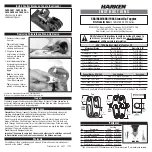
Minifors 2 - Benchtop Bioreactor
Options
07 February 2019
Page
41
of
214
4.1.1 Sensors
Optek ASD sensors are high-precision turbidity sensors. They can
be used to draw conclusions regarding the growth of microbial cul-
tures or cell cultures as a function of NIR absorption.
1 Measurement gap (optical path length, OPL)
2 Shaft, Ø 12 mm
3 PG 13.5
4 Sensor head
5 Connection (push-pull plug connection)
The sensors possess a measurement segment that is optimised in
terms of flow and sterility. The seal-free design of the sapphire win-
dow means that there are no gaps or joints. This guarantees com-
plete sterility. All components that come into contact with the media
are made of electrolytically polished steel.
Main components
1 LED light source
2 Sapphire window
3 Optical path length (OPL)
4 Daylight filter
5 Silicon photodiode detector
A defined LED light beam is shone through the process medium.
The weakening of the light intensity, which is caused by absorption
and/or diffusion by the dissolved and undissolved particles in the
carrier medium, is detected by a hermetically encapsulated silicon
photodiode.
The ASD-N sensors use the light in the near-infrared range (NIR)
of 840 nm to 910 nm.
4.1.2 Calibrating the Zero Point
Optek sensors are pre-calibrated in the factory. Inserts are availa-
ble for reference measurement.
Due to the different light absorption of different media, zero point
calibration should be performed before each cultivation process.
2
4
5
3
1
1
2
3
4
5
















































